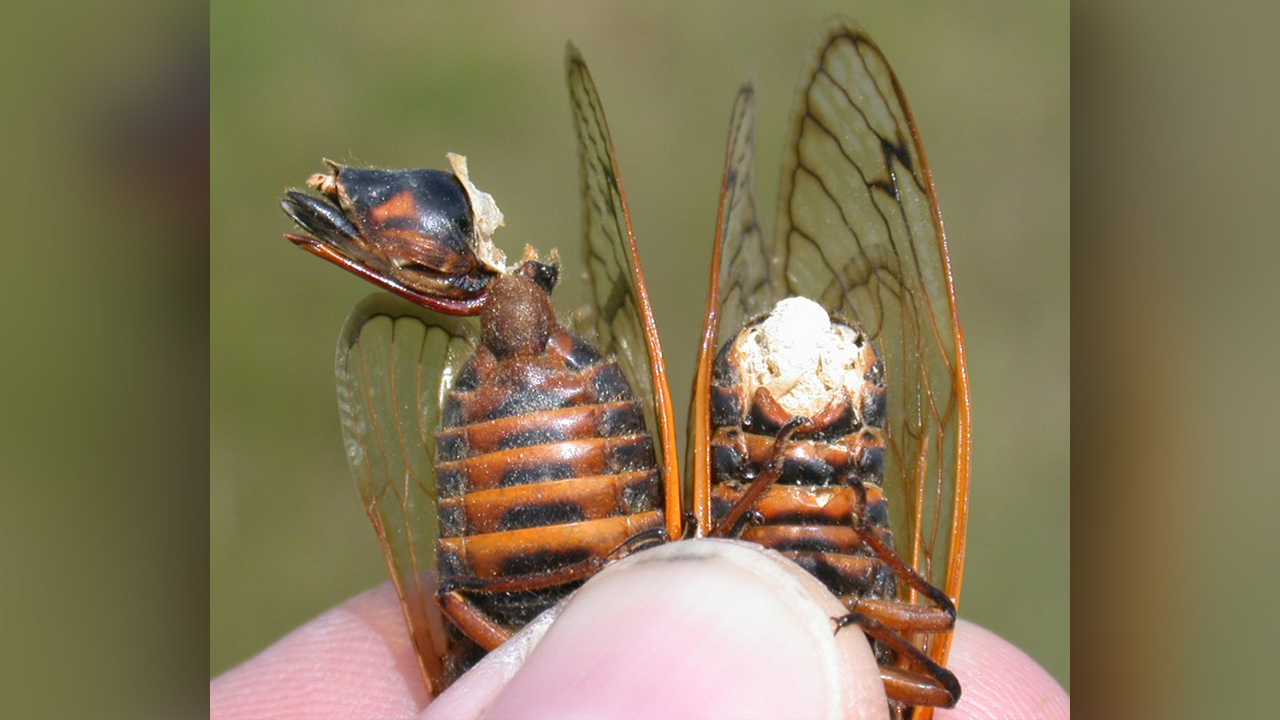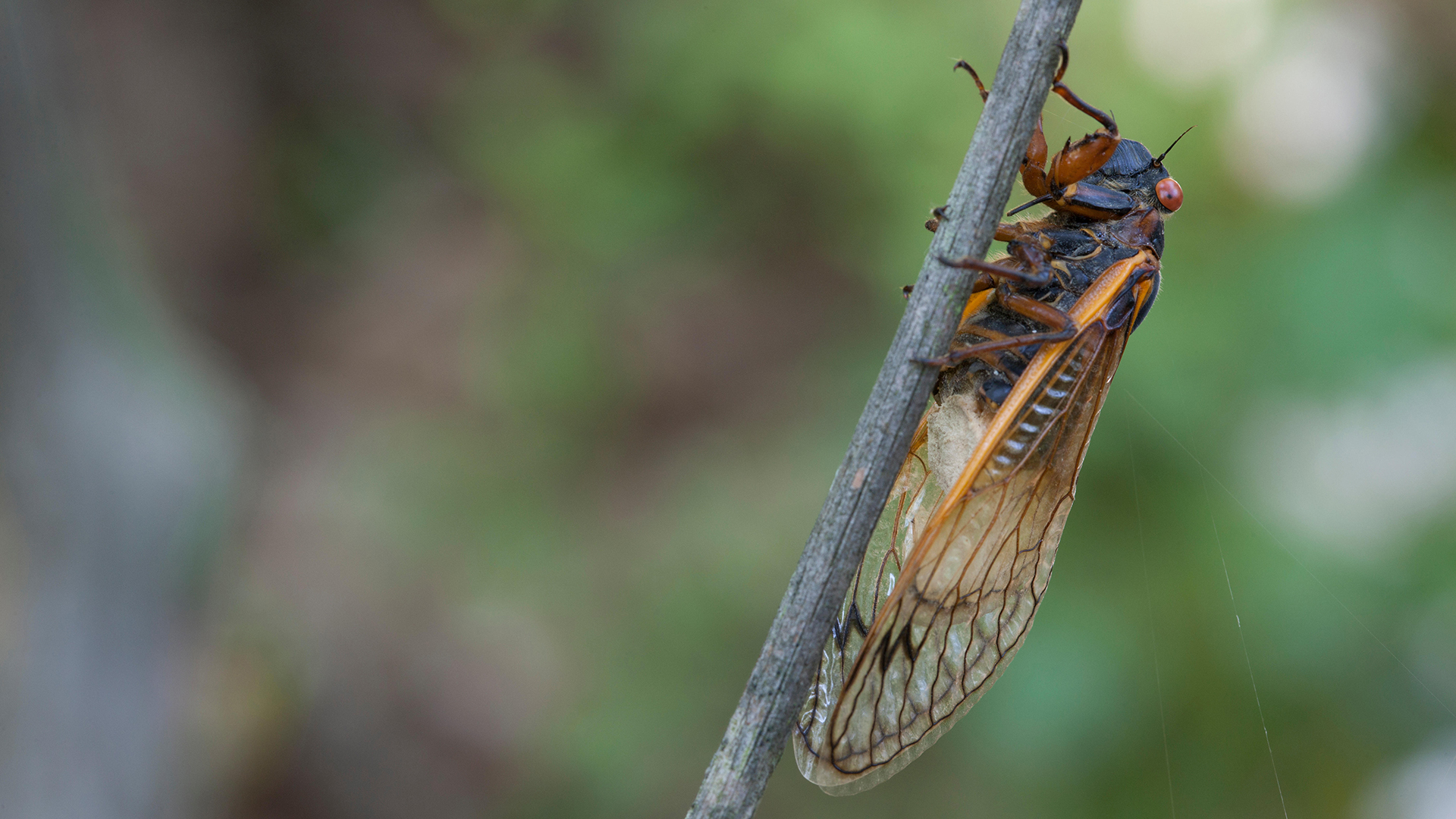Some Brood X cicadas will be sex-crazed zombies with disintegrating butts
Researcher Angie Macias described infected cicadas as "salt shakers of death" in 2013.

All Brood X cicadas want to do is mate and die in peace — is that so much to ask? Unfortunately, a number of the now-emerging cicadas may instead find themselves the victims of a zombifying fungus that transforms their butts into spore-shedding "fungal gardens."
For the past 17 years, while Brood X cicada nymphs sipped tree-root sap underground, a deadly enemy was lying in wait near those very same trees. Massospora cicadina is a fungus that targets periodical cicadas in the genus Magicicada — like Brood X — that emerge in cycles of 13 or 17 years, depending on the species. The fungus eats away at cicada butts, leaving behind a yellowish, abdomen-shaped clump of spores. The fungus also hijacks the cicadas' brains and kicks their sexual behavior into overdrive, Live Science previously reported.
When Massospora cicadina sinks its tendrils into a cicada body, the cicada is still alive, and it stays alive after its butt has been replaced by this bag of spores. At that point, the fungus manipulates the infected cicada and compels it to spread fungal spores to other Brood X cicadas by mating with uninfected insects and by flying around and dispersing the spores.
Related: What are Brood X cicadas?
"Funguses in the genus Massospora affect many different species of cicadas, but Massospora cicadina is specialized to the periodical cicada genus Magicicada," said Elizabeth Barnes, an entomologist and entomology educator at Purdue University in West Lafayette, Indiana.
"This species of fungus is actually the only pathogen or predator that specializes on periodical cicadas," Barnes told Live Science in an email. "Its life cycle lines up pretty neatly to the cicadas. Most of the time in the insect world, any given species of insect will have many organisms that specialize on eating or infecting them. It's very unusual for a whole genus of insect to only have one!"
Massospora spores lie dormant in the soil around trees, and catch a ride on the exoskeletons of emerging periodical cicada nymphs, according to entomologist Michael J. Raupp, a professor emeritus in the Department of Entomology at the University of Maryland.
Sign up for the Live Science daily newsletter now
Get the world’s most fascinating discoveries delivered straight to your inbox.
"Compounds on the surface of the cicada send a signal to the spores that dinner is served and it is time to germinate," Raupp wrote in 2020 on the university's Bug of the Week blog. "The fungus penetrates the skin of the cicada and multiplies, turning the cicada into a fungus garden."

Charles Horton Peck, a New York State botanist from 1867 to 1915, was the first to publish a description of the cicada-dissolving fungus, in the 1879 annual report for the New York State Museum of Natural History. Peck, an expert mycologist who described 2,700 species of North American fungi, declared that the cicada-infecting variety was "unlike any other known to me."
"In its early stage it is wholly concealed in the body of the insect," Peck wrote. But as the infection progresses, "the terminal rings of the abdomen fall away, revealing the pulverulent mass of spores within."
More than 130 years after Peck penned his eloquent description of zombified, infected cicadas shedding fungal spores from their backsides, researcher Angie Macias, now a doctoral candidate in plant and soil sciences at West Virginia University, dubbed the insects "salt shakers of death." Macias learned about the "murderous little fungus" when she was an undergraduate at Cornell University in Ithaca, New York, and wrote about the fungus and its cicada hosts in a 2013 blog post.
“When I go home this summer, I’m going to test the patience of my parents a little more by not only bringing the usual handfuls of mushrooms into the house, but handfuls of dead cicadas as well," Macias wrote. "I might get lucky and find one with a Massospora infection."

People who encounter Brood X cicadas this spring could certainly spot cicadas infected with the fungus, said Brian Lovett, a researcher with West Virginia University's Division of Plant and Soil Sciences, and the lead author of a 2020 study on Massospora-infected cicadas. Lovett and his co-authors found that the fungus made infected male cicadas flick their wings in the same way females do, to lure other males close enough for a dose of zombifying spores, Live Science previously reported.
"Brood X is notoriously the largest emergence, and so we expect that infections will be widespread," Lovett told Live Science in an email. "High numbers of insects benefit infectious diseases like this fungus. If even a few percent of Brood X are infected, that is a lot of infections!"
However, as Massospora cicadina only preys on periodical cicadas, infected Brood X insects won't launch a zombie apocalypse.
"This fungus is a well-established part of the ecosystem," Barnes said in the email. "It's a bit bizarre and creepy, but there's no reason to panic."
Lovett recommends that if people find infected Brood X cicadas, "they should post their observation on an app like Cicada Safari or iNaturalist to help scientists track where infections can be found," he said. "Then, I recommend excitedly sharing a selfie with your new zombie cicada friend on social media."
Originally published on Live Science.

Mindy Weisberger is an editor at Scholastic and a former Live Science channel editor and senior writer. She has reported on general science, covering climate change, paleontology, biology and space. Mindy studied film at Columbia University; prior to Live Science she produced, wrote and directed media for the American Museum of Natural History in New York City. Her videos about dinosaurs, astrophysics, biodiversity and evolution appear in museums and science centers worldwide, earning awards such as the CINE Golden Eagle and the Communicator Award of Excellence. Her writing has also appeared in Scientific American, The Washington Post and How It Works Magazine. Her book "Rise of the Zombie Bugs: The Surprising Science of Parasitic Mind Control" will be published in spring 2025 by Johns Hopkins University Press.










